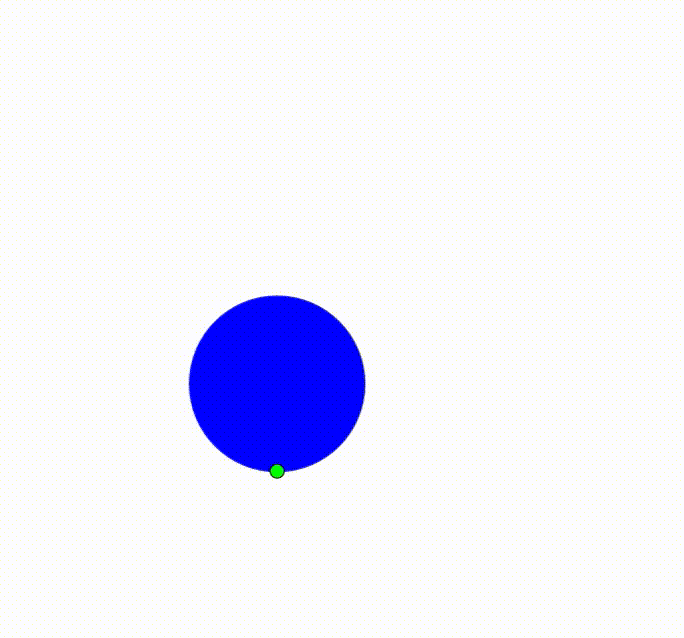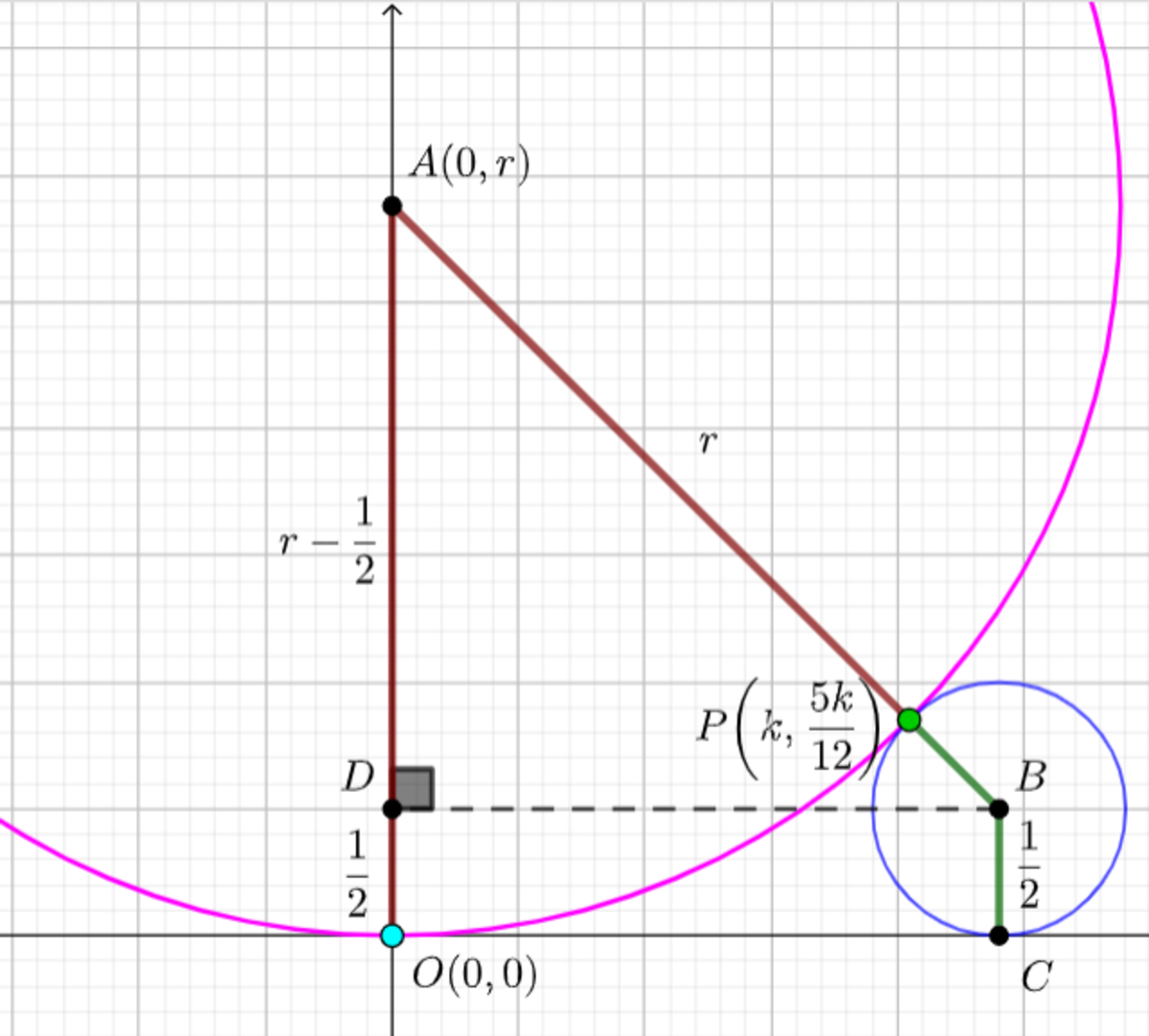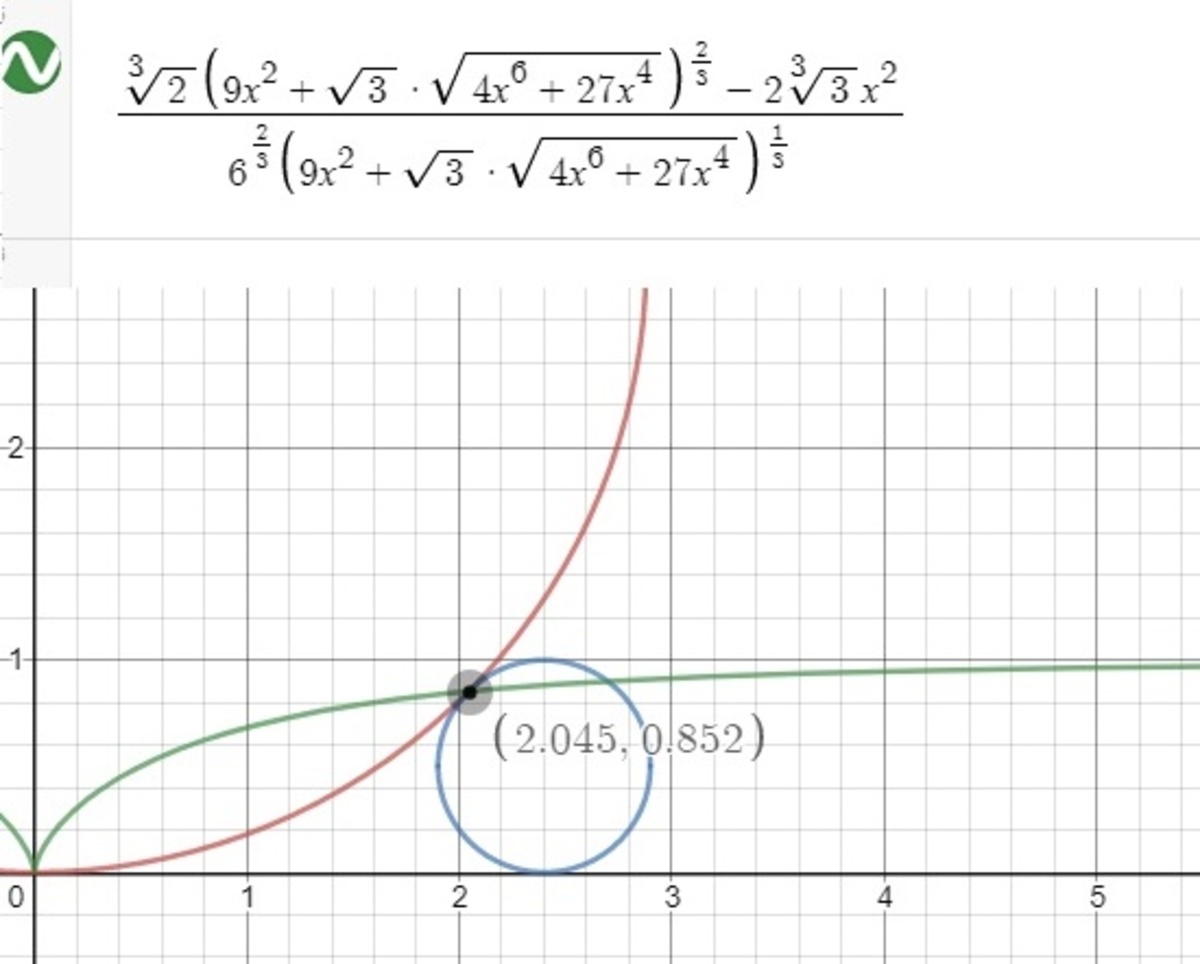Dynamic Geometry: P37
 The diagram shows a pink circle with radius
r
. The blue circle needs to be tangent to the pink circle at any moment and its radius is always equal to
2
1
; its center has coordinates
(
0
;
r
)
. The cyan point is the origin of the coordinate system. Both circles are tangent to the
x
axis. The green point is the intersection point between the circles. When the ratio of its
y
-coordinate to its
x
-coordinate is equal to
1
2
5
, the distance between the cyan point and the green point can be expressed as
b
a
where
a
and
b
are positive integers. Find
a
+
b
.
The diagram shows a pink circle with radius
r
. The blue circle needs to be tangent to the pink circle at any moment and its radius is always equal to
2
1
; its center has coordinates
(
0
;
r
)
. The cyan point is the origin of the coordinate system. Both circles are tangent to the
x
axis. The green point is the intersection point between the circles. When the ratio of its
y
-coordinate to its
x
-coordinate is equal to
1
2
5
, the distance between the cyan point and the green point can be expressed as
b
a
where
a
and
b
are positive integers. Find
a
+
b
.
The answer is 209.
This section requires Javascript.
You are seeing this because something didn't load right. We suggest you, (a) try
refreshing the page, (b) enabling javascript if it is disabled on your browser and,
finally, (c)
loading the
non-javascript version of this page
. We're sorry about the hassle.
2 solutions

Define point A as the center of the pink circle, point B as the center of the blue circle and P is the common point.
In △ A B D , A B 2 ( r + 2 1 ) 2 B D 2 ⟹ B D = A D 2 + B D 2 = ( r − 2 1 ) 2 + B D 2 = ( r + 2 1 ) 2 − ( r − 2 1 ) 2 = 2 r So the above points have coordinates, A B P O = ( 0 , r ) = ( 2 r , 2 1 ) = ( k , 1 2 5 k ) = ( 0 , 0 ) Note that P divides line segment A B into two parts, A P = r and B P = 2 1 . Using the section formula , P ( k , 1 2 5 k ) = ⎝ ⎜ ⎛ r + 2 1 r ⋅ 2 r + 2 1 ⋅ 0 , r + 2 1 r ⋅ 2 1 + 2 1 ⋅ r ⎠ ⎟ ⎞ = ( 2 r + 1 2 r 2 r , 2 r + 1 2 r ) ⟹ ⎩ ⎪ ⎪ ⎪ ⎪ ⎨ ⎪ ⎪ ⎪ ⎪ ⎧ k = 2 r + 1 2 r 2 r 1 2 5 k = 2 r + 1 2 r Solving the pair of equations, we have, r = 2 5 7 2 and k = 8 4 5 1 7 2 8 . Distance between points P and O is, k 2 + ( 1 2 5 k ) 2 = 1 2 1 3 k = 6 5 1 4 4 ∴ a = 1 4 4 , b = 6 5 ⟹ a + b = 2 0 9
Thank you for posting !
That is very kind of you, I really liked your approach, I did not even know this section formula...If you have time to post other solutions to the problems of my series, do not hesitate.
 Just as a matter of curiosity i asked Mr. Wolfram to turn the parametric equations into cartesian form.
That smooth green line predicting the position of the point is governed by this crazy equation.
Just as a matter of curiosity i asked Mr. Wolfram to turn the parametric equations into cartesian form.
That smooth green line predicting the position of the point is governed by this crazy equation.
Log in to reply
Indeed, this is why I gave up on asking the carthesian equation of this point. I still want the problems to be solvable without using any engine, or just a little bit at the very least.
Very nice, but it seems to be a hard task!
Log in to reply
I have a lot of ideas, sometimes I need to give up on them, I hope you'll like the 59 next problems of the series.
Log in to reply
@Valentin Duringer – Wow! That's a lot...
Log in to reply
@Sathvik Acharya – I already created them. I'm just posting little by little, and writting solutions does not help lol
Label the origin (cyan point) be O ( 0 , 0 ) . Let the green point be P ( 1 2 k , 5 k ) , then the ratio of y - to x -coordinate is 1 2 5 and the distance O P = 1 3 k .
Let the center of the blue circle be A ( x a , 2 1 ) , the center of the pink circle be B ( 0 , r ) , C = ( 0 , 2 1 ) , and D = ( 1 2 k , 2 1 ) . Then x a = C A = A B 2 − B C 2 = ( r + 2 1 ) 2 − ( r − 2 1 ) 2 = 2 r .
We note that △ A B C and △ A P D are similar. Then we have:
⎩ ⎪ ⎪ ⎪ ⎨ ⎪ ⎪ ⎪ ⎧ C A C D = A B P D ⟹ 2 r 1 2 k = r + 2 1 r ⟹ 6 k = 2 r + 1 r 2 r B C P D = A B A P ⟹ r − 2 1 5 k − 2 1 = r + 2 1 2 1 ⟹ 5 k = 2 r + 1 2 r . . . ( 1 ) . . . ( 2 )
⟹ ( 2 ) ( 1 ) : 2 r = 5 6 ⟹ r = 2 5 7 2 ⟹ 5 k = 1 6 9 1 4 4 ⟹ k = 8 4 5 1 4 4
Therefore, O P = 1 3 k = 6 5 1 4 4 and a + b = 2 0 9 .